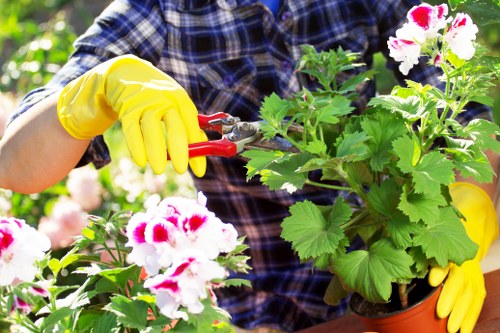Lawn Mowing Ham: Your Ultimate Guide to a Perfect Lawn

Maintaining a beautiful lawn in Ham requires dedication, the right tools, and expert knowledge. Whether you're a homeowner looking to enhance your property's curb appeal or a gardening enthusiast striving for that perfect green space, understanding the nuances of lawn mowing in Ham is essential.
Ham, a picturesque area known for its lush greenery and vibrant community, presents unique challenges and opportunities for lawn care. The climate, soil type, and local flora all play a significant role in determining the best practices for mowing and maintaining your lawn.
In this comprehensive guide, we will explore everything you need to know about lawn mowing in Ham. From selecting the right equipment to understanding seasonal care, we've got you covered.
The Importance of Regular Lawn Mowing

Regular lawn mowing is fundamental to maintaining a healthy and attractive yard. It helps control weeds, promotes even growth, and prevents the spread of pests. A well-mowed lawn not only looks good but also contributes to the overall health of your property.
Lawn mowing in Ham is particularly important due to the region's specific climate conditions. The mild weather allows grass to grow rapidly during certain seasons, making consistent mowing a necessity to keep your lawn in top shape.
Additionally, mowing your lawn regularly enhances safety by reducing the habitat for insects and small animals, contributing to a safer outdoor environment for your family and pets.
Choosing the Right Mowing Equipment

Selecting the appropriate lawn mower is crucial for effective lawn care. In Ham, where lawns can vary from small residential gardens to expansive community spaces, the type of mower you choose can significantly impact your maintenance routine.
Types of Lawn Mowers:
- Manual Reel Mowers: Ideal for small lawns, these mowers are eco-friendly and offer a quiet mowing experience.
- Electric Mowers: Suitable for medium-sized lawns, they are easier to maneuver and require less maintenance than gas-powered models.
- Gas-Powered Mowers: Best for large lawns, providing power and efficiency for extensive mowing tasks.
Consider factors such as lawn size, terrain, and personal preference when selecting your mower. Investing in high-quality equipment can save time and effort in the long run.
Best Practices for Lawn Mowing

Implementing best practices for lawn mowing ensures the health and longevity of your grass. Here are some essential tips to keep your lawn in pristine condition:
- Maintain the Right Cutting Height: Avoid cutting more than one-third of the grass blade at a time. This helps prevent stress and promotes deeper root growth.
- Keep Mower Blades Sharp: Sharp blades provide a clean cut, reducing the risk of disease and promoting healthy growth.
- Mow Regularly: Depending on the season, mow your lawn at least once a week to maintain an even appearance.
- Vary Your Mowing Pattern: Changing the direction of mowing each time prevents soil compaction and encourages grass to grow upright.
- Adequate Watering: Water your lawn deeply but infrequently to encourage strong root systems.
Seasonal Lawn Care in Ham

Different seasons require different lawn care strategies to ensure your grass remains healthy throughout the year. Here's a seasonal breakdown for effective lawn care in Ham:
Spring
In spring, focus on dethatching, aerating, and fertilizing your lawn. This helps prepare the grass for the upcoming growing season and addresses any winter damage.
Summer
During the summer months, regular mowing and watering are essential. Ensure your lawn receives adequate moisture, especially during dry spells, and continue to mow at the recommended height.
Autumn
Prepare your lawn for winter by cutting it slightly shorter and removing fallen leaves. Fertilizing in autumn can also promote healthy growth for the next spring.
Winter
Protect your lawn by minimizing foot traffic and avoiding mowing when the grass is dormant. Use a mower with a mulching feature to gently trim any overgrown areas.
Local Lawn Care Services in Ham

If you're pressed for time or prefer professional assistance, numerous lawn care services in Ham can cater to your specific needs. These experts offer a range of services, from regular mowing to specialized treatments for pests and diseases.
Hiring a local lawn care service ensures that your lawn receives tailored care based on the unique conditions of Ham's environment. Professionals are equipped with the knowledge and tools to address common lawn issues efficiently.
When selecting a lawn care provider, consider factors such as reputation, range of services, and customer reviews to ensure you receive high-quality care for your lawn.
Eco-Friendly Lawn Mowing Practices
Embracing eco-friendly lawn mowing practices contributes to a sustainable environment and promotes the health of your grass. Here are some sustainable tips to incorporate into your lawn care routine:
- Use a Reel Mower: Manual reel mowers are energy-efficient and produce no emissions, making them an environmentally friendly option.
- Mulch Your Grass Clippings: Instead of bagging clippings, mulch them to return valuable nutrients to the soil, reducing the need for chemical fertilizers.
- Opt for Electric Mowers: Electric mowers produce fewer emissions compared to gas-powered models, minimizing your carbon footprint.
- Implement Rainwater Harvesting: Collect rainwater to irrigate your lawn, conserving water and reducing utility bills.
- Plant Native Grass: Native grass species are well-suited to Ham's climate, requiring less water and maintenance.
Common Lawn Problems in Ham and Solutions
Understanding common lawn problems in Ham helps in proactively addressing them before they escalate. Here are some prevalent issues and their solutions:
Weed Infestations
Weeds compete with grass for nutrients and water, leading to a less vibrant lawn. Regular mowing, proper fertilization, and the use of organic herbicides can help control weed growth.
Pest Damage
Insects such as grubs and chinch bugs can cause significant damage to your lawn. Implement integrated pest management strategies, including natural predators and targeted treatments, to protect your grass.
Fungal Diseases
Fungal issues like brown patch and rust thrive in moist conditions. Improve lawn drainage, avoid overwatering, and apply fungicides when necessary to combat these diseases.
Thatch Build-Up
Excessive thatch can prevent water and nutrients from reaching the roots. Regular dethatching and aeration are effective methods to manage thatch levels.
Maintaining Lawn Health with Proper Nutrition
A well-nourished lawn is resilient against pests, diseases, and environmental stressors. Providing your grass with the right nutrients is key to its overall health and appearance.
Fertilization: Apply a balanced fertilizer that provides essential nutrients like nitrogen, phosphorus, and potassium. Follow a seasonal fertilization schedule to support growth throughout the year.
Soil Testing: Conduct soil tests to determine nutrient deficiencies and pH levels. Adjust your fertilization and lime applications accordingly to create optimal growing conditions.
Composting: Incorporate compost into your lawn care routine to enrich the soil with organic matter, enhancing its structure and fertility.
Watering Strategies for a Lush Lawn
Proper watering is crucial for maintaining a healthy lawn, especially during dry spells. Here are some effective watering strategies:
- Deep and Infrequent Watering: Water deeply to encourage deep root growth, but do so less frequently to prevent shallow roots.
- Early Morning Irrigation: Watering in the early morning minimizes evaporation and reduces the risk of fungal diseases.
- Use of Irrigation Systems: Install drip or sprinkler systems to ensure even and efficient water distribution across your lawn.
- Monitor Soil Moisture: Regularly check soil moisture levels to avoid overwatering or underwatering.
Enhancing Curb Appeal with Lawn Mowing
A well-maintained lawn significantly enhances your property's curb appeal. Regular mowing, edging, and trimming create a neat and inviting appearance, making your home more attractive to visitors and potential buyers.
Incorporate decorative elements such as borders, garden beds, and pathways to complement your lawn. Thoughtful landscaping paired with meticulous lawn care can transform your outdoor space into a beautiful retreat.
Tools and Accessories for Efficient Lawn Mowing
Equipping yourself with the right tools and accessories can streamline your lawn mowing process. Here are some essential items to consider:
- Protective Gear: Wear gloves, safety glasses, and sturdy footwear to protect yourself while mowing.
- Rakes and Decks: Use rakes to gather clippings and clear debris, keeping your lawn neat.
- String Trimmers: Trim edges and hard-to-reach areas for a polished look.
- Lawn Maintenance Tools: Invest in tools like aerators and dethatchers to maintain lawn health.
- Storage Solutions: Keep your tools organized and protected with proper storage solutions, ensuring longevity and ease of access.
Budgeting for Lawn Mowing Services
Investing in professional lawn mowing services in Ham can vary based on the size of your lawn, the frequency of service, and the specific services required. Here are some factors to consider when budgeting:
Service Frequency: Weekly or bi-weekly mowing services may come at a different rate compared to monthly or seasonal services.
Lawn Size and Terrain: Larger or uneven lawns may require more time and resources, affecting the overall cost.
Additional Services: Services such as fertilization, aeration, and pest control can increase the total cost but provide comprehensive lawn care.
It's advisable to obtain quotes from multiple providers and compare their offerings to ensure you receive value for your investment.
Sustainable Lawn Mowing Practices
Adopting sustainable lawn mowing practices contributes to environmental conservation and promotes a healthier ecosystem. Here are some sustainable approaches to consider:
- Reduce Mowing Frequency: Allowing your grass to grow slightly longer can improve its resilience and reduce the need for frequent mowing.
- Use Eco-Friendly Mowers: Choose mowers with low emissions or electric-powered models to minimize environmental impact.
- Implement Grasscycling: Leave clippings on the lawn to decompose naturally, returning nutrients to the soil and reducing waste.
- Plant Native Vegetation: Incorporate native plants that require less water and maintenance, promoting biodiversity.
- Compost Organic Waste: Compost grass clippings and other organic materials to create nutrient-rich soil amendments.
Common Misconceptions About Lawn Mowing
There are several misconceptions surrounding lawn mowing that can hinder effective lawn care practices. Let's debunk some of these myths:
Myth: Mowing Taller Grass Improves Lawn Health
While allowing grass to grow slightly longer can promote deeper roots, excessively tall grass can lead to thatch build-up and increased vulnerability to pests and diseases.
Myth: Frequent Mowing Necessitates More Watering
Actually, frequent mowing can conserve water by reducing evaporation rates. The key is to balance mowing frequency with proper watering practices.
Myth: Black Mowing Patterns are Ideal
High-contrast mowing patterns may look appealing initially, but they can cause stress to the grass blades, leading to weakened lawns. It's better to maintain a uniform mowing pattern.
Myth: All Grass Types Require the Same Care
Different grass species have unique care requirements. Understanding the specific needs of your grass type is essential for effective lawn maintenance.
Innovations in Lawn Mowing Technology
The lawn care industry has seen significant advancements in mowing technology, enhancing efficiency and ease of maintenance. Here are some notable innovations:
- Robotic Lawn Mowers: Automated mowers that navigate your lawn autonomously, providing consistent mowing with minimal effort.
- Smart Mowers: Equipped with sensors and connectivity features, smart mowers adjust mowing patterns based on lawn conditions.
- Battery-Powered Mowers: Offering silent operation and zero emissions, these mowers are an eco-friendly alternative to traditional models.
- Mulching Mowers: Designed to finely chop grass clippings and redistribute them back to the lawn, enhancing soil fertility.
- Adjustable Cutting Heights: Allowing for precise control over mowing settings to accommodate various grass types and growth conditions.
Personalizing Your Lawn Mowing Routine
Every lawn is unique, and personalizing your mowing routine can lead to better results. Consider the following factors to tailor your approach:
- Lawn Type: Different grass varieties have specific growth rates and care requirements.
- Climate: Ham's local climate influences mowing frequency and watering needs.
- Soil Health: Healthy soil promotes robust grass growth, reducing the need for excessive mowing.
- Usage Patterns: High-traffic areas may require more frequent mowing to maintain appearance and health.
- Personal Aesthetics: Your desired lawn appearance, whether lush and dense or neatly trimmed, will guide your mowing practices.
The Role of Lawn Mowing in Pest Control
Regular lawn mowing plays a role in managing pest populations. By maintaining a neat lawn, you reduce hiding spots for pests and make it easier to spot and address infestations early.
Moreover, properly mowed grass encourages healthy growth, making it more resistant to pest damage. Integrated pest management strategies, combined with consistent mowing, can effectively control pest issues.
Maximizing Efficiency with Lawn Mowing Techniques
Adopting efficient mowing techniques can save time and energy while producing superior results. Here are some techniques to enhance your mowing efficiency:
- Overlap Your Paths: Slightly overlap each mowing path to avoid missed spots and ensure uniform cutting.
- Change Directions: Alternating mowing directions each session prevents grass from leaning in one direction and promotes even growth.
- Maintain a Steady Pace: Moving at a consistent speed ensures an even cut and reduces the strain on your mower.
- Use Proper Posture: Maintaining good posture while mowing reduces fatigue and enhances control over the mower.
- Regular Maintenance: Keeping your mower in good condition ensures optimal performance and reduces the likelihood of breakdowns.
Enhancing Lawn Resilience Through Proper Mowing
A resilient lawn can withstand adverse conditions and recover quickly from damage. Proper mowing practices contribute significantly to building lawn resilience:
Encourage Deep Roots: Cutting grass at the right height promotes deeper root systems, enhancing drought resistance and overall health.
Promote Air Circulation: Regular mowing improves air flow within the grass canopy, reducing the risk of fungal diseases.
Reduce Stress: Avoiding excessive cutting reduces stress on the grass, allowing it to thrive even in challenging conditions.
Local Lawn Mowing Regulations in Ham
Before embarking on lawn mowing activities, it's important to be aware of any local regulations in Ham. These may include restrictions on mowing times, noise levels, and use of certain equipment.
Adhering to local guidelines not only ensures compliance but also fosters good relations with neighbors and the community. Check with Ham's local council or municipal office for detailed information on lawn care regulations.
Community Initiatives for Lawn Care in Ham
Ham boasts a strong sense of community, with various initiatives aimed at promoting sustainable and aesthetically pleasing lawns. Participating in these programs can enhance your lawn care practices:
- Community Gardens: Engage with local gardening groups to share knowledge and resources.
- Neighborhood Clean-Up Days: Participate in events focused on maintaining communal green spaces.
- Workshops and Seminars: Attend educational sessions on effective lawn care techniques and sustainable practices.
- Green Competitions: Compete in local contests that celebrate well-maintained lawns and innovative gardening.
Innovative Landscaping Ideas for Your Lawn
Enhancing your lawn extends beyond mowing. Incorporating innovative landscaping ideas can transform your outdoor space into a beautiful and functional area:
- Flower Beds: Add vibrant flower beds to create color and attract pollinators.
- Pathways and Walkways: Design paths that guide visitors through your garden, adding structure and charm.
- Water Features: Install fountains or ponds to introduce soothing water elements.
- Outdoor Lighting: Use lighting to highlight key features and extend the usability of your lawn into the evening.
- Seating Areas: Create comfortable seating spaces for relaxation and social gatherings.
Maintaining Lawn Equipment for Longevity
Proper maintenance of your lawn mowing equipment ensures longevity and consistent performance. Here are some maintenance tips:
- Regular Cleaning: Remove grass clippings and debris from your mower after each use to prevent build-up.
- Blade Sharpening: Sharpen mower blades at least once a season to maintain a clean cut.
- Oil Changes: Follow the manufacturer's guidelines for oil changes to keep the engine running smoothly.
- Battery Maintenance: For electric mowers, ensure batteries are charged and stored properly to extend their lifespan.
- Storage: Store your mower in a dry, sheltered area to protect it from the elements and reduce wear and tear.
Enhancing Soil Health for a Thriving Lawn
Healthy soil is the foundation of a vibrant lawn. Implementing practices that enhance soil health can lead to stronger, more resilient grass:
Aeration: Regularly aerate your lawn to improve soil compaction, allowing better water and nutrient penetration.
Composting: Add compost to enrich the soil with organic matter, enhancing its fertility and structure.
pH Balancing: Test and adjust soil pH levels to create optimal conditions for grass growth.
Integrating Lawn Mowing with Overall Garden Care
Lawn mowing should be part of a holistic garden care approach. Integrate mowing with other gardening activities to promote a harmonious and healthy outdoor space:
- Pruning and Trimming: Regularly prune shrubs and trees to maintain their shape and prevent them from overshadowing your lawn.
- Weed Control: Implement both manual and chemical weed control methods to keep your lawn free from unwanted plants.
- Fertilization: Schedule fertilization to supply essential nutrients and support grass growth.
- Pest Management: Monitor for pests and apply appropriate treatments to protect your lawn.
- Mulching: Use mulch in garden beds to conserve moisture and suppress weed growth.
Final Thoughts on Lawn Mowing in Ham
Achieving and maintaining a beautiful lawn in Ham requires a combination of proper mowing techniques, the right equipment, and a commitment to regular care. By following the guidelines outlined in this article, you can ensure your lawn remains healthy, vibrant, and a source of pride for years to come.

Investing in professional lawn care services, adopting sustainable practices, and staying informed about the latest lawn care innovations can further enhance the health and appearance of your lawn. Embrace the process, and enjoy the lush green space that complements your Ham property.
Frequently Asked Questions

1. How often should I mow my lawn in Ham?
The frequency of mowing depends on the grass growth rate, which varies with the season. Generally, mowing once a week during the growing season (spring and summer) and reducing to bi-weekly in cooler months is recommended.
2. What is the best time of day to mow my lawn?
The ideal time to mow your lawn is in the early morning after the dew has dried. This minimizes stress on the grass and reduces the risk of disease.
3. How do I choose the right grass type for my lawn in Ham?
Select a grass type that thrives in Ham's climate. Common choices include fescue, ryegrass, and Bermuda grass. Consider factors like sunlight, soil type, and water availability when making your decision.
4. Can I mow my lawn if it's wet?
It's best to avoid mowing a wet lawn as it can lead to uneven cuts, damage to the grass, and potential mower clogging. Wait until the grass is dry before mowing.
5. What should I do with grass clippings after mowing?
Grass clippings can be left on the lawn as mulch to provide nutrients, collected for composting, or disposed of if necessary. Mulching is generally recommended for its benefits to soil health.